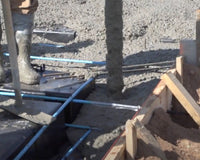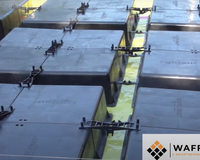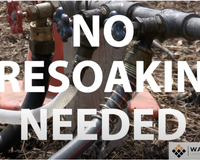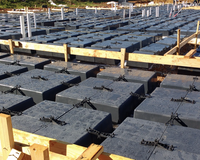Few things are more important than ground water when constructing a home and its foundation. Understanding your water table, and how groundwater behaves with your soil type is key to avoiding the expensive repairs that come with cracks, shifting, and structural damage. So, how exactly does groundwater affect soil and foundations?

Understanding groundwater under a slab foundation
95% of the world’s fresh water is underground. Even if the surface of your soil looks dry, massive quantities of water may still be found, forming complex systems that change soil conditions as it travels. To understand its impact on construction and design, here are the basics of what you need to know.
Soil and groundwater
Your soil type will determine how groundwater moves under your foundation. Groundwater is stored in the spaces between sand, rock, soil, and gravel, which is why knowing your soil type can tell you a lot about how water moves below your property. Sand is known for storing the most water because the spaces between this soil tend to have a greater volume than other layered soil types.
Clay soil is a reactive soil, expanding as it saturates and contracting as it dries. It’s also a cohesive soil, sticking together when saturated and becoming less porous. This movement can cause a variety of issues with homes and their foundations. In a home without adequate protection against soil movement, cracks will begin to form on flooring and walls, shifting the home and causing structural stress.
Aquifer and water table
The deepest layer of groundwater, aquifers, describe the soils that are saturated with water. You can think of this layer as the water supply. The water level of an aquifer is dependent on weather conditions, soil composition, proximity to water sources, and the surrounding topography.
The water table is located just above the aquifer, and it describes the layer between saturated and unsaturated soil. Here’s an easy way to visualize this. If you’ve ever dug a hole at the beach, you may have noticed how water will continuously fill the hole at a certain depth. The point at which water begins to fill the hole is the water table height. The water table height is a crucial factor in how groundwater behaves with your foundation.
How does the water table affect foundations?

If you were to visualize the movement of groundwater, it behaves similarly to any large body of water. It can travel in underground rivers or rise and fall like tides. When groundwater under a slab foundation rises, it creates an additional stress of hydrostatic pressure.
Hydrostatic pressure also forms when expansive soils like clay retain water, pushing against the walls of your foundation from all sides. Water saturation can also degrade the materials that hold a foundation together, further damaging a home with the added stress of the ebb and flow of groundwater.
More effects of water table on foundations:
- Soil instability
- Contamination
- Construction delays
- Water seepage
- Leaks and damaged flooring
- Foundation damage
- Shifting
- Expensive repairs
Know your potential for foundation water problems
Before building your home, you should understand the groundwater that runs through your property. The cost and time it takes to complete a groundwater investigation will largely depend on your soil type. In cohesive soils like clay, it can take anywhere from days to months to test because of the slow rate of groundwater movement.
A typical groundwater investigation includes imaging to study the aquifer and water table behavior through subsurface tests like drilling and boring. Environmental factors like nearby water sources, industrial activity, and climate are also considered when evaluating groundwater for construction.
In ideal conditions, your home would be far above the water table. When the water table is too high, groundwater tends to become a problem during and after construction. But you can still protect your home even if there is groundwater under a slab foundation.
High water table foundation solutions
The Wafflemat System is an above-ground foundation designed to withstand differential movement from unstable soil and a high water table. It’s a cost-effective and convenient solution that protects against a variety of soil and groundwater problems.
Other high water table foundation solutions involve complicated processes like soil conditioning or pump installations — all costly solutions that can be demanding on your construction project. The Wafflemat System saves costs on digging, additional foundation reinforcements, and the tools needed to secure a house built on a high water table.
Learn more about the Wafflemat System and how it can protect your home from bad soil types and groundwater conditions.





